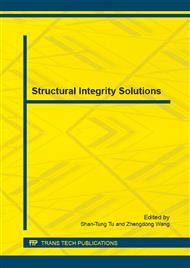[1]
J.M. Baik, J. Kameda, O. Buck. Small punch test evaluation of intergranular embrittlement of an alloy steel. Script Mitalurgica. 7(1983) 1443-1447.
DOI: 10.1016/0036-9748(83)90373-3
Google Scholar
[2]
M. Abendroth, M. Kuna. Identification of ductile damage and fracture parameters from the small punch test using neural networks. ENG FRACT MECH. 73 (2006) 710-725.
DOI: 10.1016/j.engfracmech.2005.10.007
Google Scholar
[3]
M. Abendroth, M. Kuna. Determination of deformation and failure properties of ductile materials by means of the small punch test and neural networks. Computational Materials Science. 28(2003) 633-644.
DOI: 10.1016/j.commatsci.2003.08.031
Google Scholar
[4]
R. Hu, X. Ling*. Three-dimensional numerical simulation on plastic damage in small punch specimen of Zirconium.International Journal of Pressure Vessels and Piping. 86 (2009) 813-817.
DOI: 10.1016/j.ijpvp.2009.10.008
Google Scholar
[5]
I.I. Cuesta, J.M. Alegre, R. Lacalle. Determination of the Gurson–Tvergaard damage model parameters for simulating small punch tests. Fatigue & Fracture of Engineering Materials & Structures, (2010).
DOI: 10.1111/j.1460-2695.2010.01481.x
Google Scholar
[6]
A. L. Gurson. Continuous Theory of Ductile Rupture by Viod Nucleation and Growth. J. Eng. Mat. Tech, 99(1977).
Google Scholar
[7]
V. Tvergaard. Influence of Voids on Shear Band Instabilities under Plane Strain Condition. Int. J. Fract. 17(1981) 389.
DOI: 10.1007/bf00036191
Google Scholar
[8]
Tvergaard, Needleman. Analysis of the Cup-cone Fracture in a Round Tensile Bar. Acta Metal. 32 (1984) 157.
DOI: 10.1016/0001-6160(84)90213-x
Google Scholar
[9]
A. Husain, D.K. Sehgal, R.K. Pandey. An inverse finite element procedure for the determination of constitutive tensile behavior of materials using miniature specimen. Computational Materials Science. 31 (2004) 84-92.
DOI: 10.1016/j.commatsci.2004.01.039
Google Scholar
[10]
P. Egan, M.P. Whelan, F. Lakestania, M.J. Connelly. Small punch test: An approach to solve the inverse problem by deformation shape and finite element optimization. Computational Materials Science. 40 (2007) 33-39.
DOI: 10.1016/j.commatsci.2006.10.021
Google Scholar
[11]
E.N. Campitelli, P. Spatig, R. Bonade, W. Hoffelner, M. Victoria. Assessment of the constitutive properties from small ball punch test: experiment and modeling. Journal of Nuclear Materials. 335 (2004) 366-378.
DOI: 10.1016/j.jnucmat.2004.07.052
Google Scholar
[12]
P.C. Zhai, T. Hashida, S. Komazaki, Q.J. Zhang. Numerical analysis of small punch creep tests by finite-element method. Journal of Testing and Evaluation. 32(2004) 298-303.
DOI: 10.1520/jte12250
Google Scholar
[13]
M. Abendroth, M. Kuna. Determination of deformation and failure properties of ductile materials by means of the small punch test and neural networks. Computational Materials Science. 28 (2003) 633-644.
DOI: 10.1016/j.commatsci.2003.08.031
Google Scholar
[14]
MSC. Marc Volume: A Theory and User Information, Chapter7, 2005, pp.152-154.
Google Scholar
[15]
ASTM (2004) E 8M. Standard Test Methods of Tension Testing of Metallic Materials. Annual Book or ASTM Standards, Vol. 3. 01, American Society for Testing and Materials.
Google Scholar
[16]
K. Guan, L. Hua, Q. Wang, X. Zou, M. Song. Assessment of toughness in long term service CrMo low alloy steel by fracture toughness and small punch test. Nuclear Engineering and Design. 241 (2011)1407-1413.
DOI: 10.1016/j.nucengdes.2011.01.031
Google Scholar
[17]
T. Bai, P. Chen, K. Guan. Evaluation of stress corrosion cracking susceptibility of stainless steel 304L with surface nanocrystallization by small punch test. Materials Science and Engineering. 561 (2013) 498-506.
DOI: 10.1016/j.msea.2012.10.071
Google Scholar


